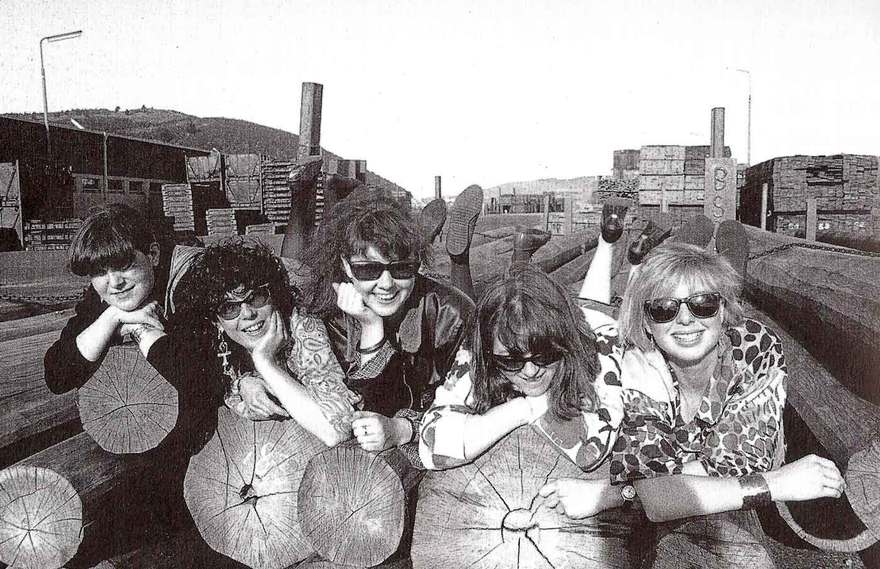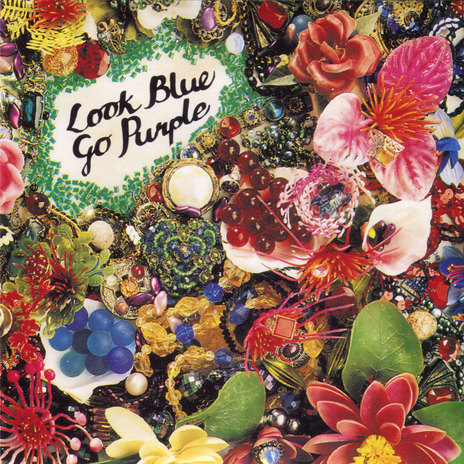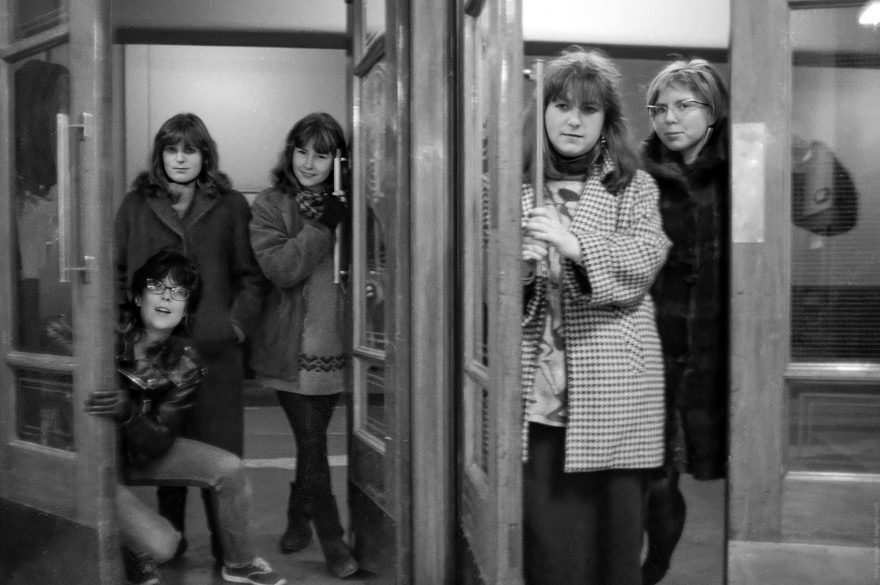
Look Blue Go Purple, Dunedin, 1985 - Denise Roughan, Kathy Bull, Lesley Paris, Norma O'Malley, Kath Webster. - photo by Jeremy Freeman
In the late 1980s, Look Blue Go Purple (LBGP) was one of the most important acts to emerge in the second wave of the seminal New Zealand indie rock label Flying Nun. “They were one of the best bands of their time and the most undeservingly underappreciated,” says musician Penelope Esplin (French for Rabbits). “They’ve inspired a generation of female musicians, most of whom stumbled across them and wondered why they weren’t more famous.”
Between 1985 and 1988, the Dunedin-based five-piece released three classic EPs, Bewitched (1985), LBGPEP2 (1986), and This Is This (1988), which Flying Nun reissued as a compilation album titled Compilation in 1991. Thirty-three years later, Compilation has been announced as the 2024 recipient of the annual Taite Music Prize’s IMNZ Classic Record award. Esplin continues: “After I discovered them, I covered ‘Safety In Crosswords’ with The Prophet Hens at a show. I couldn’t have been happier. I felt like I was introducing my generation to something really special.”

The cover of Look Blue Go Purple's 1991 self-titled compilation album
Inspired by post-punk and the lo-fi pop psychedelia of Dunedin at the time, LBGP let feeling guide their buoyant group vocals, sun-kissed guitar strum, keyboards, flute, and rollicking rhythms as they dovetailed together into a wistful and yearning sound that’s aged exquisitely.
In 2017, Flying Nun released Still Bewitched, a retrospective compilation that collects all three of LBGP’s EPs and a selection of unreleased live recordings. Close to half a decade in the making, it was an important step towards restoring LBGP’s rightful importance within Flying Nun’s storied history. Seven years after Still Bewitched’s release, LBGP’s legacy only feels more vital.
“Going through our archives made me cry,” admits LBGP bassist Francisca Griffin (formerly Kathy Bull), the driving force behind Still Bewitched. “You don’t know what you’re doing when you’re in the middle of it, which isn’t that important because you’re doing it and you love what you’re doing. In retrospect, we were really different and good.”
Speaking by phone from her home in Dunedin, where she works as a naturopath, Griffin was working through memories from three and a half decades ago. In the process, she reflected on the era when she connected with her LBGP bandmates, Norma O’Malley, Denise Roughan, Kath Webster, and Lesley Paris. After sizing each other up on the local music scene in 1983, LBGP started meeting up several times a week in the basement of a Dunedin record store.
“I would go into the store, and Lesley would put records in my face and make me buy them,” Griffin remembered. “I don’t know how we decided to start a band, but I remember Norma saying her friend Kath could play guitar so we could rope her in. Lesley was already drumming, so she was good. Denise was a fledgling guitar player, so some of our first songs didn’t have much guitar in them because she and Kath were learning. I had my bass and synthesiser, Norma had her keyboards and flute.”

Look Blue Go Purple, 1983. From left: Kathy Bull (in front), Denise Roughan, Lesley Paris, Norma O'Malley, Kath Webster. - Terry Moore
With a shared love of the likes of Blam Blam Blam, Miles Davis, John Coltrane, The Velvet Underground, Television, Pere Ubu, The Slits, Scritti Politti, A Certain Ratio, Joy Division, and The Raincoats, they were a musically open-minded bunch. They also had a healthy sense of humour (“We had a lot of in-jokes,” says Griffin, laughing) and a sisterlike group relationship. Between these connective threads, LBGP struck upon something special.
“We hung out all the time,” Griffin says. “Some of us lived in the same places. We were all over each other’s lives.” More Do It Together than DIY, they didn’t let their early limitations hold them back. “I don’t think the idea of limitations even occurred to us,” Griffin recalls. “We’d look at what other bands were doing and go; we can do that! Let’s just try it out. We’re not good on guitar yet? That’s okay; we’ll do other things.”
Thinking back, Griffin remembers LBGP’s songwriting process as democratic and inclusive. “It was about bringing ideas together,” she said. “Someone would bring a guitar line, a synth line, or a lyric, and we’d make up parts to it. Sometimes, we’d make things up together. Denise and I were early for practice one day, so I made up a bassline; she did some guitar that was the same as the bassline, wrote some words, and that became ‘I Don’t Want You Anyway’. We knew if the songs were right by feeling.”

Look Blue Go Purple, 1983. Standing, left to right: Kathy Bull, Denise Roughan, Lesley Paris. Seated are Norma O'Malley (left) and Kath Webster. - Michael Smith
LBGP quickly progressed from the practice room to the local stages. In 1984, they played two consecutive shows at The Empire Hotel. “The bar was packed,” Griffin said. “We sold out both nights. At the end of the second night, we had this big bag of money. I remember holding up a big wad of cash and saying, ‘Look! Look what we did!’”
Emboldened, LBGP bought new music gear and started playing around the country alongside the likes of The Chills, The Bats and Straitjacket Fits. Live performances led to recording sessions at The Lab in Auckland with audio engineer Terry Moore for their first EP, Bewitched. “Lots of those songs were first or second takes with everyone recording simultaneously,” Griffin says. “We always worked with recording engineers who got us. Live, or in the studio, the relationship between a band and their engineer is crucial.
“I remember sitting in the studio with Terry Moore, the rest of the band and David Merritt – our tour manager at the time – when we were listening to our recordings for the first time. When we were listening to the rough mixes for Bewitched, we looked at each other and went, wow, is that what we sound like? You never have any idea of that when you’re on stage.”
On release, Bewitched was a breakthrough success, peaking at No.21 in the New Zealand pop charts and staying in the Top 50 for nearly eight weeks. “We were astonished and excited,” Griffin enthuses. “Look at that: they’re all selling, people like it.”
The following year, they went to Progressive Studios in Auckland with Terry Moore to record their second EP, LBGPEP2 (1986). “That time, we were a lot fussier while recording,” Griffin admitted. “It took me six hours and a new set of strings to get the bassline down for ‘Cactus Cat’.”
At its peak, LBGP was operating in an era when local live music was thriving, and there was a unique energy in the air. “That ridiculous cultural cringe carry-on you get sometimes didn’t occur to us much at all,” Griffin says. We were riding a wave, I guess. It was more like – where is the party tonight? Let’s go! Everyone was busy playing, and the bars were full. You couldn’t spend Saturday night on the internet back then.”
Regardless of the energy of the time, their experiences as live musicians weren’t always magical and could be downright horrible at times. Although being part of the Flying Nun scene located them inside an emerging musical counterculture, that counterculture still existed within a climate powered by rugby, cheap beer and the aftermath of Robert Muldoon’s National Party government. “When the counterculture collided with the mainstream, it wasn’t pretty,” Griffin says.
“That ridiculous cultural cringe carry-on ... didn’t occur to us much at all” – Francisca Griffin
They had particularly bad experiences playing shows at the agricultural colleges in Palmerston North and Lincoln – so bad they skipped both campuses on their next university tour. “There were a few places where we’d have boys giving us arseholes,” Griffin laughed. “We gave them double back. Rumours were going around that I found pretty offensive. When men exhibited the behaviour we were exhibiting, they were celebrated, but when women did it, we got vilified.”
However, as they travelled around New Zealand, those darker moments were tempered by brand new audiences, audiences who owned their records and knew the words to their songs. “It was absolutely amazing,” remembers Griffin.
As five women playing together under the shadow of post-punk, LBGP was often labelled a feminist band by the media, a title they respectfully had no interest in and continue to have no interest in. “Over the years, the five of us have tirelessly tried to correct this idea that we were a feminist band,” Griffin explains. “We weren’t a feminist band. We did want to play with our friends who were women, but we didn’t want to play with them because they were women. We were a band of five musicians who happened to be women. It’s interesting that it’s taken over 30 years for the world to figure that out. There are lots of musicians who want to get messages across, and kudos to them. We never wanted to get any messages across except ‘here are our songs’.”
Despite a promising run, after recording their third EP This Is This with Tex Houston and Peter Jefferies, LBGP called it a day in 1987. Lesley wanted to go travelling, Griffin was pregnant with her first child, and things were changing. Over the following decades, their music acquired a cult following among Flying Nun fans in New Zealand and abroad. Things ramped up with YouTube, where even a cursory search throws up an impressive number of live performance videos from the 80s and excellent music videos for crucial LBGP cuts such as ‘Cactus Cat’ and ‘Circumspect Penelope’.
In retrospect, every upload contributed to a perfectly understated set-up for the release of Still Bewitched in 2017. “Back in the day, I was eerily obsessed with collecting stuff of ours,” Griffin reflects. “All kinds of bits of paper, posters, photos, live recordings.” She might not have thought about why at the time, but in 2017, it was all finally starting to make sense. Seven years on, Griffin’s archival efforts around LBGP and the band’s legacy only feel more vital and relevant.
--
Read more: Look Blue Go Purple
Read more: Look Blue Go Purple’s Bewitched